Introduction
Dedicated to the memory of Danny "Parameterdown" SuthivarakomWhat is Tokimeki Memorial?
Tokimeki Memorial (TokiMemo) is a series from Konami that started in 1994 and quickly became as synonymous with the company as Castlevania. The first game alone has been released for 8 consoles, while the TokiMemo franchise has spawned 3 sequels, dozens of side games, a Girl's Side franchise aimed at female audiences, and sold so much merchandise that the Konami Style store still sells it to this day.
The game classifies itself as a "Romance simulation" (恋愛シミュレーション), a genre which brings a lot of derision outside of Japan but really isn't all that different from playing The Sims. In all of the main TokiMemo games, you take on the role of a Japanese high school student from the first day of freshman year until graduation day. Along the way, you build up stats that represent your skill at sports, aptitude for academics, or good looks. All of these help you get into good colleges, ensure your future employment, and ideally, win you the heart of one of the ensemble cast of potential high school sweethearts.
While it sounds pretty plain - and it is, at least for the early ones - the games were groundbreaking for their time. They were huge hits (well, except for 3), spawned dozens of imitators, and their influence can still be seen today in games like Harvest Moon, Persona, Mass Effect, Dragon Age, and many, many more.
Why are the Japanese so obsessed with high school, anyway?
To understand why so much Japanese media obsesses over high school life, you have to understand how Japanese society worked in the '90s. In general, Japanese companies used a "membership-based" model of employment, which was (and is) unique to Japan. The membership model of employment means that Japanese companies don't hire people to fill specific positions, instead hiring people based on how dedicated to the company they will be. To quote a fascinating article: "Instead of recruiting and hiring workers with specific skills to perform particular work when needed, Japanese companies have generally hired young people en masse immediately upon their graduation from college (or, especially in earlier days, from high school) by taking applications from students before they graduate and attempting to select ones with the latent ability to do any sort of work that the company may assign them."
This means that for most people about to enter the workforce, their actual college education was essentially meaningless unless they went to a trade school; they couldn't really train for a specific field of work because they had no idea what field of work they were going into, they just knew what kind of company they wanted to be hired by. The moment students were accepted into college, their quality of life for the rest of their lives had essentially been decided for them based on the prestige level of the school.
Let that sink in for a moment; imagine a world where your entire working life has already been laid out for you based on your college acceptance letters. Got into UC Berkeley or Oxford? Congratulations, you are guaranteed to be a hot commodity before you've even graduated. Forced to settle for community college? Good luck getting the third-rate jobs, loser.
This meant that for most people, high school was the last time in their lives where they felt like they had any freedom and control over their destinies. This is a big reason why high school life was so romanticized by Japanese culture. Today, while college educations have become a little more specialized to working life, high school still represents the last time in many Japanese people's lives where they can be carefree.
Why TokiMemo?
Tokimeki Memorial helped create a genre. The visual novel didn't really gain traction until Leaf's To Heart was released in 1997, and while Tokimeki Memorial wasn't the first game of its kind - as far as we can tell, that honor goes to Elf's Doukyuusei, an adult game released in 1992 - it was the first one that was available to the mass market. The characters are a lot of fun, and you can see echoes of them in modern Japanese games too.
I first played this game in high school, and it had a pretty big impact on my life. It's one of the tools I used to learn Japanese, it's a game I forged lifelong friendships over, and hey, the 20th anniversary is coming up! Why not share the love with the goons?
What can we expect from this LP?
Over the course of this thread, I plan on playing through every Tokimeki Memorial game in order. At major decision points, I'll throw it up to all of the readers so that they can choose how the character's life goes within certain limits - no quadruple Forever Alone endings, please. On the way, I'll touch on topics like Japanese culture and education, anime character archetypes, and miscellaneous trivia. Any questions you might have, I'll field!
Are there any rules?
Just be polite! And, please, be smart about spoilers.
Tokimeki Memorial
Tokimeki Memorial: Introduction and Shiori run
- Chapter 1: The First Day of School
- Planning for Perfection: Or, How I Learned to Start Worrying and Hate the Bomb
- Chapter 2: Spring 1995, a Tale of Trumpets and Being Bad at Sports
- Chapter 3: Summer 1995, Close Encounters of the Yuina Kind
- Chapter 4: Summer 1995, part 2 - These Six Times at Band Camp
- Chapter 5: Fall 1995, Ducking and Weaving
- Chapter 6: Christmas 1995, Groundhog Goon
- Chapter 7: New Year's 1996, Not THE God, just A God.
- Chapter 8: Spring 1996, Walking the Tightrope
- Chapter 9: Spring 1996 Part 2, The Baby-Faced Assassin
- Chapter 10: Summer 1996, The Path of Perfection Begins
- Chapter 11: Fall 1996, Bear Territory Part 1
- Chapter 12: Fall 1996, Bear Territory Part 2
- Chapter 13: The Smell of Napalm in the Morning
- Chapter 14: Winter 1996/97, Groundhog Christmas 2
- Chapter 15: Winter 1997, All Downhill from Here
- Chapter 16: Spring 1997, My Name is Goonzymandias, Teen of Teens
- Chapter 17: Summer 1997, The Mark of Goon's Dignity Shall Scar Thy DNA
- Chapter 18: Fall 1997, What is a Goon? A Miserable Pile of Perfection!
- Chapter 19: Winter 1997/98, All Realities, All Dimensions are Open to Goon
- Chapter 20: I am Goon. The End Has Come!
Tokimeki Memorial: Yuina run
- Yuina, Chapter 1: A Goon of a Different Color
- Yuina, Chapter 2: Enter the Archnemesis
- Yuina, Chapter 3: One Crazy Summer
- Yuina, Chapter 4: It's Only Cheating If You're Caught
- Yuina, Chapter 5: Wizardry
- Yuina, Chapter 6: I'm So Into You, But I'm Way Too Smart For You
Tokimeki Memorial 2

Tokimeki Memorial made Konami a ton of money. Character merchandise, spinoff games, sold-out concerts... Konami wasn't stupid. They knew that the formula worked, and they intended to outdo themselves with the sequel, which was released in November of 1999 - 5 months before the release of the PlayStation 2.
Prologue
- Meet the Cast!
- The Making of Goon2
- Prologue: Raising the Flags of Childhood, part 1
- Prologue: Raising the Flags of Childhood, part 2
Table of Contents (Maho route)
- Chapter 1: Homecoming
- Chapter 2: Get in.
- Chapter 3: 50 first dates
- Chapter 4: Spot the differences!
- Chapter 5: Summer vacation
- Chapter 6: No More Mister Nice Goon
- Chapter 7: I'll never let go, Goon
- Chapter 8: Erase / Rewind
- Chapter 9: Settling into a rhythm
- Chapter 10: Being a better wingman, plus the obligatory fight scene
- Chapter 11: A summer filled with frogs and fish
- Chapter 12: Attack of the Childhood Friends
- Chapter 13: Dropping the act
- Chapter 14: Preparing for the home stretch
- Chapter 15: Can't Stop Won't Stop
- Chapter 16: Burn
- Chapter 17: Bad Girl
- Chapter 18: Confessions
- Chapter 19: Confessions, part 2
Table of Contents (Akane route)
- Character Poll 2
- Akane route, chapter 1: Live by the sword
- Akane route, chapter 2: Jumping on the grenade
- Akane route, chapter 3: Making enemies
- Akane route, chapter 4: You're so money, and you don't even know it
- Akane route, chapter 5: Go! Go! Muscle!
- Akane route, chapter 6: Playing with fire
- Akane route, chapter 7: Time's up
- Akane route, chapter 8: Peace and quiet
- Akane route, chapter 9: A time to love
- Akane route, chapter 10: A time to hate
- Akane route, chapter 11: Of monsters and men
- Akane route, chapter 12: The last stand
- Akane route, final chapter
What's new in the second game?
The most obvious change is that Tokimeki Memorial 2 takes place in Hibikino, a city right next door to Tokimeki Memorial's Kirameki city. Hibikino is apparently the sister city of Eugene, Oregon, because holy crap that green and gold color scheme burns itself into the eyes.
Tokimeki Memorial for the Super Famicom came in at around 3.2 MB. Tokimeki Memorial: Forever With You added a whole lot of voiced lines and graphics, and it weighed in at 480 MB. If you look, you can see where they had to cut corners in order to be able to squeeze all of that voice data onto a single CD - tons of repeated lines with very small variations, and only 5 unique events for each character. Tokimeki Memorial 2 blew it out of the water in terms of size, spanning 5 discs and weighing in at a whopping 2206 MB.
So, there's more of everything. More music. More voiced lines and unique events for each character. More mini-games. More character animation, both for the 2D sprites and for the super-deformed 3D character models. More places to go. More character interaction - as in, the characters can actually talk to each other and appear at the same time! More male characters - and all of them are actually, confirmably male... although there is that weird dream you can have about Takumi. And overall, a whole lot more personality!
There were a few significant quality of life changes, most notably with the bomb system. It's way easier to dodge bombs in Tokimemo 2 than it was in the first Tokimemo, and even if you do brain fart and let a bomb go off, there's a relationship chart that shows how much the girls like each other, which in turn affects how they're affected by bombs from other girls.
Tokimemo 2 also heaped on new features along with simple gameplay changes. I'll be going over these a lot, but the earliest features you bump into are EVS (Emotional Voice System) and the childhood portion of the game.
What's the Emotional Voice System?
It's Konami's predecessor to the Vocaloid system (note that the development of Vocaloid started in 2000, and was first released in 2004). For the EVS, all of the Tokimemo 2 voice actresses recorded every Japanese phoneme, and by patching together those files, the game can produce something that sounds like your name, instead of that awkward pause wherever $playername appeared in the script of the first Tokimemo. Certain names break in the Japanese-only sound system (I remember "Dom" sounding especially heinous), and it has some pretty severe restrictions due to hardware limitations. One girl's voice data devours pretty much an entire PlayStation memory card, and you can only have one EVS active per playthrough. In addition, only Hikari and Kasumi were available for EVS in the original game. To get EVS for any of the other girls, you had to use add-on discs that came with copies of the Tokimemo 2 magazine, the Hibikino Walker (affectionately known as the Hibikino Stalker for its in-depth coverage of all of the characters).
Overall, though, it's a pretty neat system. You can download extra EVS discs from the PlayStation Network, and yes, I will buy the EVS disc for whichever girl becomes the target of the first playthrough!
What's the childhood portion?
The childhood portion of the game represents 5 days in 1992 when the PC is 8 years old. It's meant to establish relationships between many of the characters, and provide more backstory than "This is Shiori, and you'll have to take my word for it that we've been friends forever, because she'll treat me like I don't exist for two years." It's full of Childhood Promises and other devices that you can find in pretty much every teen romance anime/manga ever, and it also makes Hikari seem kind of annoying, but it pays off later in the game.
Like many other gimmicks, it's neat the first time you see it, but becomes annoying on later playthroughs - thus why I'll only be doing it once, and doing it Perfectly.
Why are the Japanese so fixated on childhood friends, anyway?
It's not just the Japanese. What the Japanese call an osananajimi ("childhood friend") operates on many of the same levels as the "Girl Next Door" and "Girl Back Home" archetypes that have been a staple of fiction for centuries. It's an easy way to establish the kind of relationship between two characters that takes the entirety of When Harry Met Sally to build otherwise. Want to show that two characters have a strong familial/fraternal bond that hints at the potential for romance?
Step 1: Write the words "Remember that time when we...?"
Step 2: Make up something that the speaking character would remember X years later
Step 3: Profit!
On a less jaded level, the osananajimi archetype is a flexible tool that sings to different parts of the Japanese soul. In many cases, the osananajimi is the Sibling You Never Had But Is Okay To Marry, playing the role of a playmate and surrogate family member to legions of latchkey kids deprived of parental affection. Or, to the many Japanese who move from suburban and rural areas to work in the city, the osananajimi represents everything that is good back home, the Family and Tradition that have been left behind and replaced by the Office and the Corporate life. And in many teenage romances, the osananajimi is a desperately needed anchor/safety valve in the turbulence of adolescence, a person who knows who you were and accepts who you are becoming - and conveniently happens to be both pretty and very much in love with you. There are many more levels to it, but that's a topic for a completely different time (plus, The World God Only Knows has already done a ton of yelling about it).
Let's get into the cast, and the first character poll!
Tokimeki Memorial 2 - LP birthday run!
- Homura route, chapter 1: The worst president in history
- Homura route, chapter 2: The winds of the king
- Homura route, chapter 3: King in the North
- Homura route, chapter 4: The queen's ire
- Homura route, chapter 5: The Lord of the Lake versus the Hibikino Hero
- Homura route, chapter 6: Sometimes you're the dragon, and sometimes you're the princess
- Homura route, chapter 7: My last act as president
Tokimeki Memorial 3
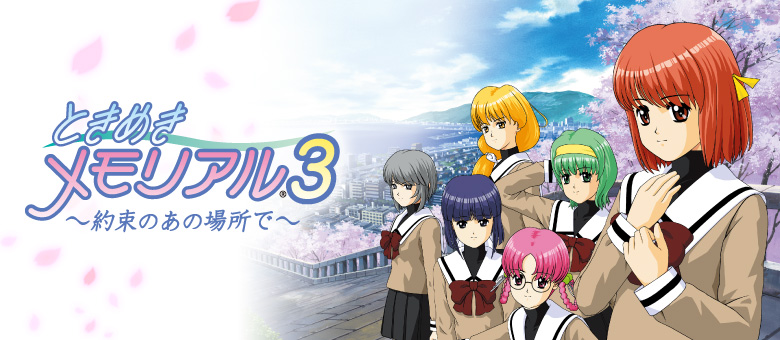
Yes, this is real. No, I am not allowing takesies-backsies.
Table of Contents
- Tokimemo 3, Chapter 1: Working the clock
- Tokimemo 3, Chapter 2: Working the system
- Tokimemo 3, Chapter 3: Working for the weekend
- Tokimemo 3, Chapter 4: Working hard, not smart
- Tokimemo 3, Chapter 5: Working through the pain
- Tokimemo 3, Chapter 6: Working toward a better tomorrow
- Tokimemo 3, Chapter 7: But... the future refused to change
- Tokimemo 3, Chapter 8: Snake? Snake? SNAAAAAAAKE!
- Tokimemo 3, Chapter 9: Let us go out this evening for pleasure.
- Tokimemo 3, Chapter 10: The night is still young.
- Tokimemo 3, Chapter 11: And they were never heard from again.
- Tokimemo 3, Chapter 12: You've met with a terrible fate, haven't you?
- Tokimemo 3, Chapter 13: Fission Mailed
- Tokimemo 3, Chapter 14: The Pain
- Tokimemo 3, Chapter 15: The Sorrow
- Tokimemo 3, Chapter 16: The Fury
- Tokimemo 3, Chapter 17: The End
- Tokimemo 3, Chapter 18: The Fear
- Tokimemo 3, Chapter 19: The Joy
Ladies and gentlemen, we are gathered here today to mourn the death of Tokimeki Memorial. The poor girl died on December 20, 2001 under unfortunate circumstances, when she was thrown onto the PlayStation 2 when she just wasn't ready. The reason? As with so many other untimely game deaths, the reason was money.
Why? Why did this tragedy have to happen?
To understand the reason Tokimemo 3 died, you must understand what was going on with both Konami and Japan at large at the time.
The '90s in Japan are known as the Lost Decade, a time of deep recession and the very very conservative investment that come with it. Even with the success of Tokimeki Memorial 2 and the Beatmania franchise - and don't get me wrong, Konami was doing pretty well on those fronts - Konami couldn't coast on Tokimemo 2 side games and new iterations of Dance Dance Revolution forever. In order to fund new development, Konami created Game Fund Tokimeki Memorial (AKA the Tokimemo Fund) in 2000, a kind of proto-crowdfunding that had already found success in funding the development of Metal Gear Solid and Suikoden. Interestingly, the Tokimemo Fund didn't just fund Tokimemo 3 - it also funded an experimental spin-off of Tokimeki Memorial that was going to be aimed at girls, known as Tokimeki Memorial Girl's Side.
The way the Tokimemo Fund worked was pretty different from how crowdfunding works now. Unlike Kickstarter, which is more like a pre-order with benefits, the Tokimemo Fund was an open-ended development funding corporation set up in the Bahamas (likely for tax purposes).
What's that mean?
The difference between the Tokimemo Fund and Kickstarter is that the Tokimemo Fund was an actual investment. Konami promised to pay interest off of the profits from Tokimemo 3 and Tokimemo Girl's Side. The minimum buy-in for the Tokimemo Fund was 100,000 yen (about USD 830 at the time, USD 1,110 in today's dollars), and for buying into the fund, investors got Kickstarter-style benefits, like pre-orders of the Limited Edition and their name in the credits.
Tokimemo 3's trouble started with the Tokimemo Fund - investors committed 12 billion yen ($10 million then, $13.4 million now) to the fund, but only 7.7 billion yen ($6.4 million then, $8.5 million now) actually materialized.
This forced two games to be made on a little over half of their planned budget.
By the way - in 2003, the Tokimemo Fund paid out 10,088 yen per 10,000 yen invested. There was a 3.15% handling fee charged at the time of the original transaction in 2000, so investors essentially lost 2,270 yen over 3 years per 100,000 minimum investment.
This is why Konami has not tried this funding method again.
Money doesn't explain everything, does it?
No, it doesn't, but it certainly didn't help. There was a lot more that went wrong with Tokimeki Memorial 3. Fans started to notice some problems when the game was unveiled with 6 main characters, a significantly smaller cast than Tokimemo 1 and Tokimemo 2 and a sign of rushed development.
So, what is actually different between the previous games and Tokimeki Memorial 3?
The obvious thing first: someone at Konami decided to take advantage of the PS2 and experiment with cel-shaded 3D animation instead of traditional 2D sprites. The time required to create a new art style and graphics engine from scratch, along with the usual troubles associated with transitioning from PlayStation to PlayStation 2, ate a huge amount of the team's efforts and resulted in far less time spent on the things that had made the previous Tokimemo games successful.
Tokimemo 3 is set in Moegino, a fictional city that doesn't seem to be anywhere near Kirameki and Hibikino, to the chagrin of fans who wanted to see Tokimemo easter eggs. Interestingly, these series easter eggs are present in Girl's Side, which just makes you wonder why they chose to leave them out of 3. The legendary tree of 1 and bell of 2 are replaced by a legendary hill, which may inspire dread in those familiar with the KimiNozo/Rumbling Hearts series.
Unlike the previous games, which featured songs by the voices of the main heroines, the opening and ending songs are performed by the legendary band/vocalist Zard, and the opening can be seen here:
https://www.youtube.com/watch?v=yUkgmB76X8Y
There are a few significant system changes, especially related to stats, but those can wait until I actually start the game.
Is there a Shiori-alike in this game?
I dunno. Maybe.
Okay, let's step back a little. When do we get to meet the cast?
Soon. But first, I'd like you guys to suggest new titles for the thread! All of my ideas are mostly unprintable, due to my opinion of this installment.
Many thanks, as usual, to Good Guy Seiya, who is able to explain economics to me as if I were a third grader.
Tokimeki Memorial Girl's Side
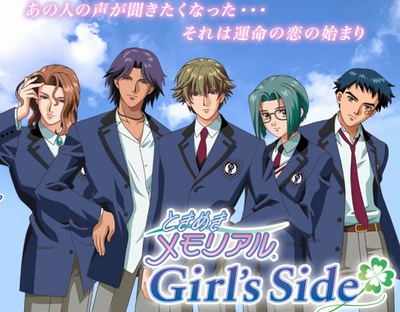
Table of Contents
- Tokimemo Girl's Side Chapter 1: A Whole New World
- Tokimemo Girl's Side Chapter 2: When Will My Life Begin?
- Tokimemo Girl's Side Chapter 3: I Wonder
- Tokimemo Girl's Side Chapter 4: Learn Me Right
- Tokimemo Girl's Side Chapter 5: Whistle While You Work
- Tokimemo Girl's Side Chapter 6: Reflection
- Tokimemo Girl's Side Chapter 7: Dig a Little Deeper
- Tokimemo Girl's Side Chapter 8: Poor Unfortunate Souls
- Tokimemo Girl's Side Chapter 9: I'll Make a Man Out of You
- Tokimemo Girl's Side Chapter 10: (You're the) Devil in Disguise
- Tokimemo Girl's Side Chapter 11: I Won't Say (I'm in Love)
- Tokimemo Girl's Side Chapter 12: I See the Light
- Tokimemo Girl's Side Chapter 13: Never Smile at a Crocodile
- Tokimemo Girl's Side Chapter 14: A Spoonful of Sugar
- Tokimemo Girl's Side Chapter 15: Go the Distance
- Tokimemo Girl's Side Chapter 16: I've Got No Strings
- Tokimemo Girl's Side Chapter 17: Almost There
- Tokimemo Girl's Side Chapter 18: Someone's Waiting for You
What is Tokimeki Memorial Girl's Side?
It's the other result of the Tokimemo Fund, which funded Tokimeki Memorial 3. As its name implies, it's aimed at the female gaming audience, trying to horn in on territory that Koei's famed Angelique series of female-oriented dating games had established in 1994. The game was released in June 2002, a full 6 months after Tokimemo 3 killed the male side of the franchise.
It didn't try to do anything especially new. 2D graphics. Game mechanics that didn't stray too far from that of other established games in the genre. A focus on writing and character, not on experimental graphics. And it became a wild success for just that reason. The game has, to date, been remade twice and has had two fairly successful sequels, which have also been rereleased for Nintendo DS.
I have all of these questions, why aren't they answered in this OP?
Because I want to play this game blind for my first time! That means no spoilers, please! I don't want to know what happens. I don't want to know who's in the cast until I meet them. I don't want to know how to get every event or how to deal with every new mechanic. I'm fine with advice, but please keep it general and not "you have to go to X date spot in Y season for Z event to happen". That ruins the purpose of a blind run.
Feel free to be entertained by my wild speculation and limited imagination! I'll go back and do a more thorough playthrough after this one, I promise.
So who are all these hot boys, anyway? Are they part of a band?
Beats me! I'll meet 'em when I meet 'em.
I can make some guesses based on their profile pictures, though. This section will be updated as I learn more about the characters!
Name: Hazuki Kei.
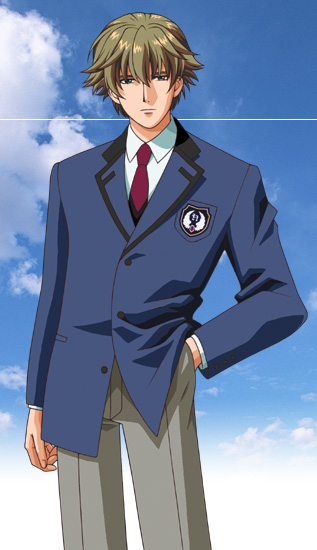
Archetype at a glance: Bad boy with a heart of gold.
Dangerous Hotness level: 9/10. He has a sort of young Leonardo DiCaprio vibe to him that probably means that he's either an underwear model or a biker.
Non-threatening Boys Magazine rating: 1/10. Watch out, girls, this one's going to steal your heart and ride off into the sunset with it! But he'll come back to you some day.
Voiced by: Midorikawa Hikaru!
Midorikawa Hikaru's signature robot role: Heero Yuy (Gundam Wing).
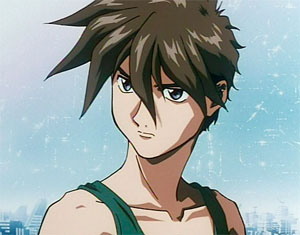
Midorikawa Hikaru's most, uh, "special" role: Kabukichou Mesugurohyoumonchou (Hikounin Sentai Akibaranger)
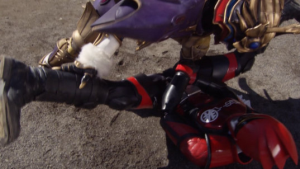
What I think every time he opens his mouth: "I will kill you."
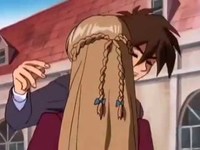
Name: Morimura Sakuya.
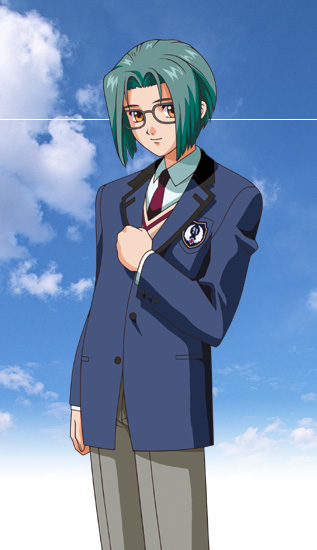
Archetype at a glance: Loyal, bookish type who would never cheat on you because his self-confidence is low.
Dangerous Hotness level: 1/10. His reaction to a girl hitting on him would probably be utter confusion.
Non-threatening Boys Magazine rating: 10/10. Lisa Simpson would call a 900 number to listen to him talk about the latest book he's been reading.
Name: Suzuka Kazuma.
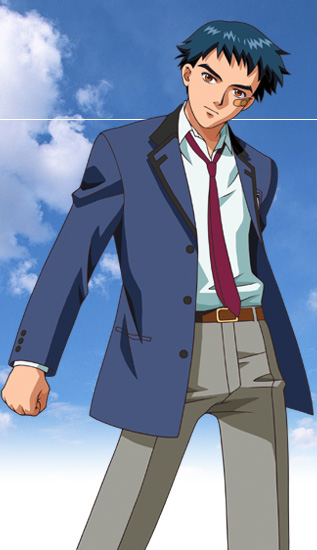
Archetype at a glance: Sporty, rough around the edges but one good woman short of being a gem.
Dangerous Hotness level: 6/10. The bandage on his face speaks to his brutish ways, but also speaks of a vulnerability that only you can reach, girls!
Non-threatening Boys Magazine rating: 7/10. He's brusque to everyone at first, but once you show him some TLC he'll be a puppy.
Name: Kijyo Madoka
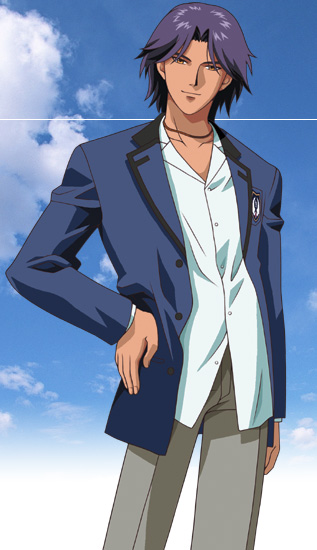
Archetype at a glance: Playboy with a wandering eye.
Dangerous Hotness level: 10/10. He'll break your heart and won't even realize it.
Non-Threatening Boys Magazine rating: 3/10. He's just looking for the right girl to tame his wild heart, and that could very well be you!
Name: Mihara Shiki
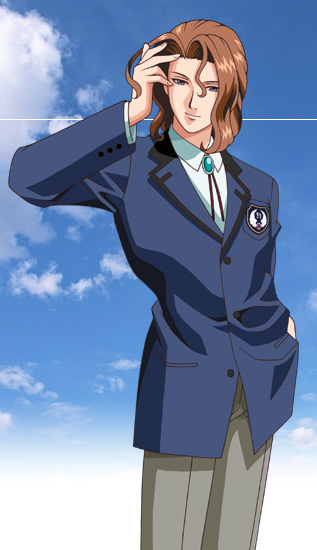
Archetype at a glance: Arrogant rich kid
Dangerous Hotness level: 7/10. He and his clique of rich friends probably rule the school's social circles, and he'll give you a red card if you anger him! He'll also make fun of your economic status constantly, before finally admitting his admiration of your fiery spirit and defending you fiercely for the rest of the
Non-Threatening Boys Magazine rating: 4/10. He's not as big of a bad boy as the others, but you'll have to crack through his facade of wealth and privilege first.
Name: Himuro Reiichi
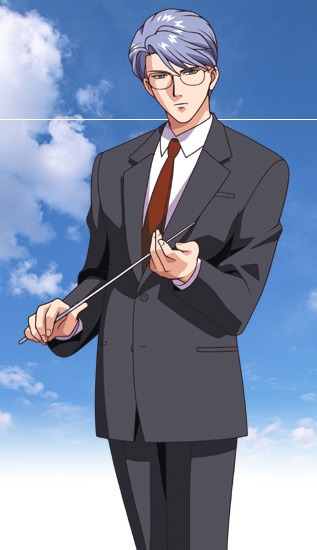
Archetype at a glance: Hot teacher
Dangerous Hotness level: 4/10. Deceptive, however; most of the danger and hotness comes from the forbidden nature of the student-teacher relationship.
Non-Threatening Boys Magazine rating: 0/10. Those are the eyes of a stone-cold murderer.
Voiced by: Koyasu Takehito
Koyasu Takehito's signature robot roles: Zechs Merquise (Gundam Wing), Gym Ghingham (Turn A Gundam)
Koyasu Takehito's most, uh, "special" role: Komoro-kun the poisonous mushroom (Papuwa)
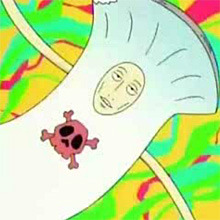
What I think every time he opens his mouth: ONOREEEEEEE
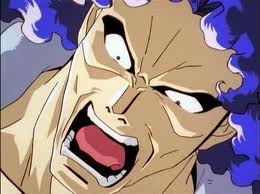
Name: (Fudou) Tsukushi
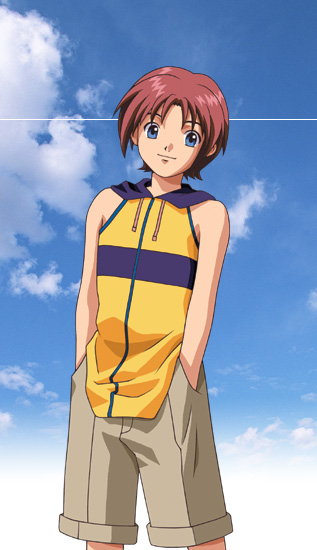
Archetype at a glance: Scheming little brother
Dangerous Hotness Level: Eww.
Non-Threatening Boys Magazine rating: Eww.
Voiced by: Orikasa Ai
Orikasa Ai's signature robot role: Quatre Raberba Winner (Gundam Wing)
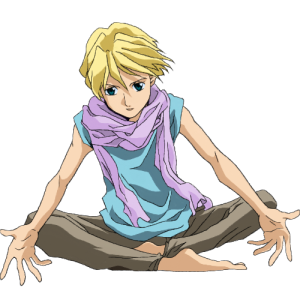
Orikasa Ai's most, uh, "special" role: Kevin McAllister (Home Alone, Japanese dub)

What I think every time she opens her mouth: Ultimate! Gespenst! KiiiiIIiiiIIiIIIiIIck!